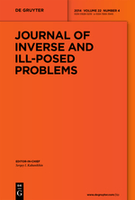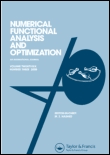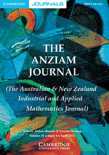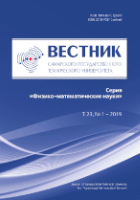
Journal of Inverse and Ill-Posed Problems
Scope & Guideline
Fostering Innovation in Mathematical Modeling
Introduction
Aims and Scopes
- Inverse Problem Formulation and Analysis:
The journal emphasizes the development of mathematical formulations for inverse problems, exploring their properties, uniqueness, and stability. This includes a variety of mathematical methods and theories applied to inverse problems in physics, engineering, and applied mathematics. - Regularization Techniques:
A core area of research involves the application and development of regularization methods to handle ill-posedness of inverse problems. This includes Tikhonov regularization, iterative methods, and adaptive approaches to ensure stability and convergence of solutions. - Numerical Methods and Algorithms:
The journal publishes studies on numerical techniques and algorithms used to solve inverse problems, including iterative methods, optimization techniques, and computational algorithms designed to improve efficiency and accuracy in real-world applications. - Applications of Inverse Problems:
Research published in the journal covers a wide range of applications, including medical imaging, geophysics, materials science, and environmental modeling, demonstrating the interdisciplinary nature of inverse problems. - Theoretical Developments in Inverse Problems:
The journal highlights theoretical advancements related to inverse problems, including new mathematical insights, stability results, and innovative approaches to complex problems that arise in various scientific contexts.
Trending and Emerging
- Machine Learning and Data-Driven Approaches:
There is a significant increase in studies applying machine learning techniques to inverse problems, showcasing the integration of artificial intelligence in enhancing solution accuracy and efficiency. - Fractional Calculus and Fractional Differential Equations:
Recent publications have increasingly focused on inverse problems involving fractional calculus, highlighting a trend towards exploring the complexities and applications of fractional differential equations in modeling real-world phenomena. - Hybrid and Multi-Scale Methods:
Emerging themes include the development of hybrid methodologies that combine different mathematical techniques or scales, allowing for more robust and adaptable solutions to complex inverse problems. - Applications to COVID-19 and Public Health:
The journal has seen a surge in research addressing inverse problems related to COVID-19 modeling and public health, reflecting the urgency and relevance of these topics in contemporary research. - Neural Networks and Surrogate Modeling:
There is a growing trend towards utilizing neural networks and surrogate models to tackle inverse problems, emphasizing the shift towards computationally efficient and effective solutions.
Declining or Waning
- Traditional Inverse Scattering Methods:
There has been a noticeable decline in publications focused on classical inverse scattering methods, as newer techniques and hybrid approaches gain traction. This reflects a shift towards more sophisticated and adaptive algorithms that can better handle complex data. - Basic Regularization Techniques:
Basic regularization methods, once a predominant focus, are now less frequently addressed in favor of more advanced and tailored regularization strategies that account for specific problem characteristics and noise levels. - Single-Disciplinary Approaches:
Research that strictly adheres to traditional single-disciplinary approaches has decreased, with a growing trend towards interdisciplinary studies that incorporate methodologies from various fields, such as data science and machine learning.
Similar Journals

SIAM JOURNAL ON APPLIED MATHEMATICS
Pioneering Research for a Mathematical TomorrowSIAM Journal on Applied Mathematics, published by SIAM Publications, is a leading academic journal that has been an essential resource for researchers and practitioners in the field of applied mathematics since its inception in 1969. With an impressive impact factor that places it in the Q1 category for Applied Mathematics and a respectable Scopus rank of #172 out of 635, this journal serves as a vital platform for sharing innovative research, methodologies, and applications that bridge theoretical mathematics and practical problems across diverse industries. Although the journal does not currently offer open access options, it remains a cornerstone of mathematical literature in the United States and worldwide, featuring rigorous peer-reviewed articles that address critical issues and advancements in the field. Researchers, professionals, and students are encouraged to engage with its rich repository of knowledge and contribute to the ongoing dialogue in applied mathematics, making it a must-subscribe journal for anyone invested in this dynamic discipline.

JOURNAL OF HEURISTICS
Transforming complex challenges with heuristic insights.JOURNAL OF HEURISTICS, published by Springer, is a prominent platform dedicated to advancing the field of heuristics in various domains such as Artificial Intelligence, Computer Networks and Communications, Control and Optimization, Information Systems, and Management Science and Operations Research. With a dedicated ISSN of 1381-1231, this journal plays a crucial role in disseminating innovative research and methodologies that push the boundaries of these interconnected fields. Holding a notable Q2 ranking in multiple disciplines and a Q3 ranking in Artificial Intelligence for 2023, this journal stands out particularly in niche areas, evidenced by its strong Scopus rankings, with high percentiles reflecting its impact and reach. Although the journal is not an Open Access publication, it continues to serve as an invaluable resource for researchers, professionals, and students eager to explore and utilize heuristic approaches in solving complex problems. With converging years from 1995 to 2024, it offers a wealth of historical data and contemporary advancements, making it a key reference point in the academic community.

Mathematical Foundations of Computing
Exploring Theoretical Insights for Modern ComputingMathematical Foundations of Computing, published by the American Institute of Mathematical Sciences (AIMS), is a distinguished open-access journal that has been actively disseminating influential research in the fields of Artificial Intelligence, Computational Mathematics, Computational Theory and Mathematics, and Theoretical Computer Science since its inception in 2009. With its E-ISSN 2577-8838, this journal is committed to providing researchers and practitioners with cutting-edge mathematical theories and methodologies that underpin modern computational practices, which is critical for advancing the field. The journal proudly holds a Q3 categorization in several relevant domains as of 2023, reflecting its contribution and accessibility amid an evolving academic landscape. By offering open access to its content, it ensures that vital research is freely available to a global audience, enhancing collaboration and innovation. Positioned in the heart of the United States, Mathematical Foundations of Computing serves as a crucial resource for advancing knowledge and fostering discussions among researchers, professionals, and students passionate about the mathematical underpinnings of computing.

NUMERICAL FUNCTIONAL ANALYSIS AND OPTIMIZATION
Advancing mathematical frontiers through innovative analysis.NUMERICAL FUNCTIONAL ANALYSIS AND OPTIMIZATION, published by Taylor & Francis Inc, is a premier international journal dedicated to advancing the fields of analysis, optimization, and applied mathematics. With its ISSN 0163-0563 and E-ISSN 1532-2467, this journal has established itself as a vital resource for researchers and practitioners seeking to explore innovative methodologies and applications. Covering a broad spectrum of topics intersecting mathematical analysis and computer science, it has consistently ranked in the Q2 tier for Analysis and Control and Optimization categories and is well-regarded in the communities of Signal Processing and Computer Science Applications. The journal's commitment to publishing high-quality research ensures significant contributions to solving complex problems in various fields, making it an essential reference for students, academics, and industry professionals. With a publishing history dating back to 1979, it encourages the dissemination of groundbreaking ideas and practical methodologies, fostering a collaborative academic environment. Access to the published articles may vary, so contributors and readers are encouraged to engage with the latest findings and ongoing research through the journal’s platform.

ANZIAM JOURNAL
Connecting Scholars to the Latest Mathematical AdvancesANZIAM JOURNAL, published by Cambridge University Press, serves as a pivotal platform for disseminating high-quality research in the field of mathematics. With an ISSN of 1446-1811 and an E-ISSN of 1446-8735, this journal caters to a diverse audience, including researchers, professionals, and students interested in the latest advances and applications in mathematics, particularly in the miscellaneous category. Having a Scopus rank of #42 out of 90 in its field and sitting at the 53rd percentile, the ANZIAM JOURNAL emphasizes rigorous peer-reviewed research while fostering innovative mathematical discussions. Since its inception in 2000, it has continuously evolved, maintaining a commitment to excellence and accessibility, with open access options available to reach a wider audience. The journal's geographic roots in Cambridge, England, further underscore its prestigious standing in the academic community. Researchers and practitioners alike will find indispensable insights and developments within its pages as it looks toward a vibrant future through 2024 and beyond.

Vestnik Samarskogo Gosudarstvennogo Tekhnicheskogo Universiteta-Seriya-Fiziko-Matematicheskiye Nauki
Elevating Academic Discourse in Physics and MathematicsVestnik Samarskogo Gosudarstvennogo Tekhnicheskogo Universiteta-Seriya-Fiziko-Matematicheskiye Nauki is a distinguished academic journal published by SAMARA STATE TECHNICAL UNIVERSITY, specializing in the fields of physics and mathematics. With an ISSN of 1991-8615 and an E-ISSN of 2310-7081, this journal has provided an open access platform since 2006, fostering the dissemination of innovative research and developments within the international scientific community. It has made significant strides in its impact and relevance, achieving a Q3 ranking across various categories including Analysis, Applied Mathematics, Condensed Matter Physics, and Mathematical Physics, as of 2023. Located in Samara, Russian Federation, the journal serves as a vital resource for researchers and professionals, offering insights that bridge theoretical frameworks and practical applications. With its commitment to advancing knowledge in mechanics, modeling, and simulation, the journal not only enhances academic discourse but also supports the growth of emerging talents in the field. For those seeking to explore cutting-edge studies and contribute to meaningful scientific discussions, Vestnik Samarskogo Gosudarstvennogo Tekhnicheskogo Universiteta-Seriya-Fiziko-Matematicheskiye Nauki stands out as an essential publication.

JOURNAL OF COMPUTATIONAL MATHEMATICS
Bridging Theory and Application in MathematicsJOURNAL OF COMPUTATIONAL MATHEMATICS, published by GLOBAL SCIENCE PRESS, is a distinguished peer-reviewed academic journal dedicated to advancing the field of computational mathematics. With a focus on high-quality research that bridges theoretical and practical applications, this journal aims to disseminate innovative methodologies and robust algorithms that address complex mathematical problems. Operating without an open-access model, it maintains a reputable standing with a Q2 category classification in computational mathematics as of 2023, showcasing its influence and relevance within the academic community. The journal, which has been in publication since 1996, continues to evolve, providing a platform for researchers, practitioners, and students to engage with cutting-edge developments up to 2024. By contributing to the body of knowledge in computational mathematics, this journal plays a vital role in fostering collaboration and advancement in related disciplines.

Eurasian Journal of Mathematical and Computer Applications
Advancing the Frontiers of Mathematical and Computational Innovation.Eurasian Journal of Mathematical and Computer Applications, published by the prestigious L N GUMILYOV EURASIAN NATIONAL UNIVERSITY in Kazakhstan, stands as a vital platform for researchers and professionals engaging in the fields of Applied Mathematics, Computational Mathematics, Computer Science Applications, Information Systems, Mathematical Physics, and Modeling and Simulation. With its ISSN 2306-6172 and E-ISSN 2308-9822, this academic journal aims to foster innovative research and facilitate knowledge transfer in these interdisciplinary domains. The journal, which converges its endeavors from 2013 to 2024, is currently ranked Q3 across its various categories in 2023, reflecting its growing influence and commitment to academic excellence. Despite its open access availability, the journal's dedication to quality research is evident as it attracts contributions that not only advance theoretical understanding but also address practical applications. With a supportive community of researchers in an increasingly important field, the Eurasian Journal of Mathematical and Computer Applications is poised to remain a significant resource for those seeking to propel the boundaries of mathematical and computational sciences.

International Journal of Computing Science and Mathematics
Unveiling New Dimensions in Applied Mathematics and ComputationThe International Journal of Computing Science and Mathematics, published by INDERSCIENCE ENTERPRISES LTD, is a pivotal platform for the dissemination of cutting-edge research in the intertwined disciplines of computing science and mathematics. With an ISSN of 1752-5055 and an E-ISSN of 1752-5063, the journal primarily serves the academic community engaged in applied mathematics, computational mathematics, theoretical computer science, and more, making significant contributions that resonate across various fields of technology and science. While the journal is currently categorized in the Q4 quartile for multiple related fields, including Applied Mathematics and Computational Theory, it continues to strive towards advancing the knowledge and practice within these areas. Spanning years from 2007 to 2010 and again from 2012 to 2024, the journal seeks to publish high-quality, peer-reviewed articles that not only address theoretical advancements but also explore practical applications of computing science in mathematical contexts, thereby fostering collaboration among researchers, professionals, and students alike. Please note that this journal is not available as Open Access, thus ensuring a curated content selection intended for dedicated research communities.

SIAM JOURNAL ON SCIENTIFIC COMPUTING
Empowering Research Through Rigorous Peer ReviewSIAM Journal on Scientific Computing is a premier journal published by SIAM Publications, focusing on the interdisciplinary domain of scientific computing. With a significant standing in the academic community, this journal boasts a 2023 Q1 ranking in both Applied Mathematics and Computational Mathematics, positioning it among the top-tier publications in these fields. The journal aims to disseminate high-quality research that applies computational methods to solve scientific and engineering problems, fostering advancements in numerical analysis, algorithms, and software development. Researchers and professionals can greatly benefit from the journal's rigorous peer-review process and its reputation for publishing cutting-edge studies. Though it is not an open-access journal, subscribing institutions and individual subscribers gain access to a wealth of knowledge tailored for those seeking to enhance their expertise in scientific computation. With its established history since 1996 and continuing to publish until 2024, the SIAM Journal on Scientific Computing remains an essential resource for students, researchers, and professionals dedicated to pushing the boundaries of this dynamic field.